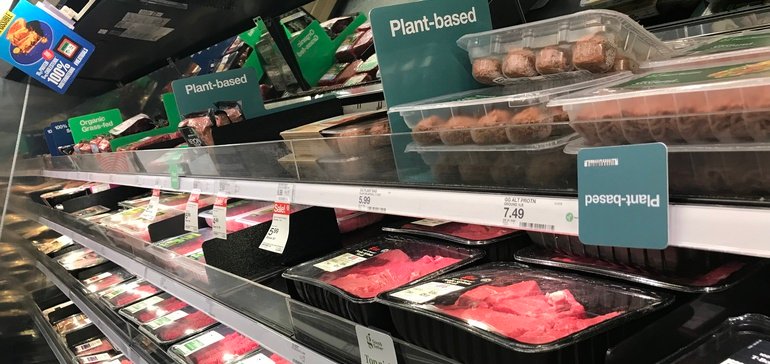By the numbers: Plant-based food sales and prices

Plant-based food has been trending upward with more sales overall, more product options online and on shelves, and more categories.
As a growing number of products become available to retailers, it’s clear that this segment is getting more popular with consumers of all kinds of eating habits. In 2020, plant-based food retail sales grew 27% to be worth $7 billion, according to SPINS data released by the Good Food Institute and the Plant Based Foods Association. And even as consumers spent more money on groceries due to the pandemic, the plant-based segment grew at a faster clip than traditional products as a whole.
There are many reasons for the growth. One is obvious: More products are available. According to Food Dive’s tracker, 40 new plant-based or fermented meat analog products have found their way to shelves or menus so far in 2021. Manufacturing capacity has also expanded for products that have become consumer favorites. For example, in 2020, Impossible Foods went through a massive retail expansion, going from 150 stores selling its products at the beginning of the year to more than 20,000 this spring.
Changes in the way grocers put plant-based products on shelves have also supported growth. A study last year by Kroger and the Plant Based Foods Association found that plant-based meat shelved next to its traditional counterparts sold 23% better. More retailers have been adopting this strategy in the past year and are using other ways to drive more sales.
These sales figures from SPINS quantify how plant-based is getting to be big business for retailers and manufacturers alike. SPINS looked at dollar sales and pricing for the 52 weeks ending July 11 and compared them to the previous year. The statistics reflect sales and prices in multi-outlet stores in the United States.
According to SPINS data, the largest sales growth came in the plant-based category’s more mature segments: refrigerated milk and meat. However, sales are growing in smaller sectors too, including frozen desserts and creamers.
Plant-based sales have increased across the board in the last year
Dollar sales in U.S. stores, in millions
Category by category, plant-based sales grew more than those for the products they aim to replace. Some of the products that drove these increased sales are in segments that benefited from new innovation and product launches, like plant-based chicken. Other segments have started to substitute plant-based ingredients for their normal components, like ready-to-drink coffee mixed with oat milk. While some of these statistics may be skewed by a previously smaller category experiencing massive growth, like plant-based jerky, others show continued expansion in an established segment, like frozen plant-based meat.
Plant-based food saw much larger sales growth in the last year than traditional counterparts
Dollar sales percent change in the 52 weeks ending July 11, 2021
Since plant-based products are new on the market and may use novel and previously untapped ingredients and processes, prices have initially been higher than those for the products they aim to replace. Manufacturers in the space have long said price parity — where the cost is the same for plant-based and traditional animal-sourced products — is vital to drive more widespread adoption of the sector.
These statistics look at average retail prices of comparable plant-based and animal-sourced products in multi-outlet grocery stores nationwide. This includes all products in a category, so numbers may be skewed in categories with a variety of items, including meat, poultry and seafood. In this data set, refrigerated and frozen animal-based meat were grouped together, while the two categories were separated under plant-based. The figure for all animal-based meat is used for comparison in both categories for plant-based products.
The widest price gap is between plant-based and traditional shelf-stable condiments, dressings and marinades, with plant-based versions costing an average of $2.21 more. Manufacturers have been making shelf-stable plant-based condiments for years, but some of these products may be more premium. There’s also more than a dollar difference between traditional and plant-based RTD teas and coffees, as well as dips and salsas.
Plant-based meat manufacturers have said price parity is especially important for their products because consumers are more likely to try a new item that is not much more expensive than the animal-based counterpart. For smaller segments, the price gap may not make as much of a difference. Consumers may be willing to spend more money on a product that they believe is premium — like a fancy snack — regardless of whether it is plant-based or not.
Plant-based products often cost more than their traditional counterparts
Average retail prices at U.S. multi-outlet grocery stores in the 52 weeks ending July 11, 2021
Source: fooddive.com

